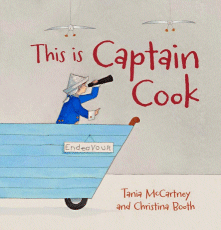This is Captain Cook
Tania McCartney
Christina Booth
NLA Publishing, 2015
40pp., hbk., RRP $A24.99
9780642278692
Miss Batt’s class have been studying Captain Cook and instead of the usual posters and PowerPoint shows, they have turned what they have learned into a play to be presented to their parents as living history.
The story opens with all the usual flurry of such events as the audience greets each other and gets ready to be entertained, while the children sort themselves out on stage. The first scene is of Captain Cook’s childhood, and there are the usual latecomers, those with nerves, the “hi dads” and one frightened chook – all resonant with anyone who has produced or attended a school play. As we follow Cook’s life and adventures through the voice of the narrator, the actions of the children and some very clever props, there is much for the reader to learn about this remarkable man. And throughout, the chook (who has now escaped the arms of its keeper) is causing concern for the stage hands and humour for the reader. Its encounters with the kiwi, the kangaroo and the penguin are priceless and as it becomes more and more agitated the audience who have been patiently watching their offsprings’ performances become a little distracted.
This is the most unique way of presenting old material in a new light that I’ve seen for a long time. There have been dozens of books about Captain Cook because of his place in our history, and yet McCartney and Booth have created something new and interesting that will engage the audience as well as teach them and perhaps even have them clamouring to produce something similar as they delve deeper into his life. Even though the text itself is written in a style reflecting that of a narrator so there is little embellishment on the basic facts (apart from Cook’s love of shiny buttons), the details in the illustrations bring the story to life. Unlike some pictures books, there has clearly been a close collaboration between autor and illustrator as characters, props, movement, speech bubbles and, of course, the chook add animation and understanding so that even the very young (or those just learning our language and history) will begin to get a sense of who this man was. For it is a story about the man – the mariner, the father and the adventurer – and not that of the impact that such exploration had on the lives of indigenous peoples. That is a discussion for an audience much older than the one intended for this book.
However, it could serve as a model for understanding what a biography is, the sort of information that that genre contains, the range of sources that can be used to gather it and check its veracity, and even a model for the children to write their own play about someone else. Such an approach would incorporate many strands of the curriculum, differentiating it so each has something to offer and show students that history need not be dull and boring.
It is also the perfect introduction to the National Library of Australia’s collection of artefacts relating to Cook, his journeys and his life and there are pages at the back that show some of what is available in the library and online. Teaching notes are available.
Definitely one for the collection.

